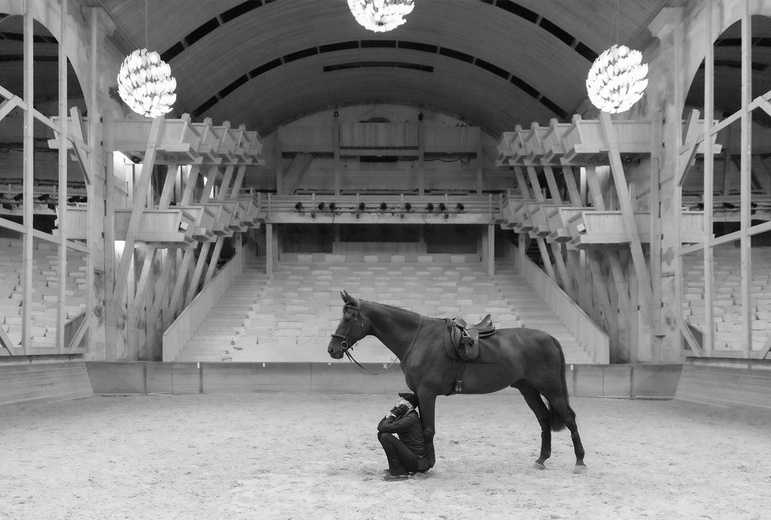Entretiens silencieux
Intimisme, finesse et subtilité - Enjeux artistiques
Difficile d’imaginer deux univers plus éloignés l’un de l’autre : d’un côté, Bartabas, fondateur du cirque Zingaro devenu Théâtre équestre Zingaro, de l’autre l’Ircam, à la pointe des technologies du son. Ils ont pourtant en partage un domaine essentiel : celui du spectacle et de la représentation. Faisant preuve d’une curiosité sincère pour les univers sonores singuliers, le premier a du reste déjà abordé les musiques de création, s’associant par exemple à Jean-Pierre Drouet en 1991 pour son Opéra équestre, ou reprenant le Dialogue de l’ombre double de Pierre Boulez pour accompagner le dernier volet de son Triptyk en 2000.
Lorsque Bartabas et l’Ircam se rapprochent autour de ce projet particulier, intitulé Entretiens silencieux, l’idée du célèbre écuyer est à la fois spectaculaire et intimiste : mettre en valeur ce dialogue ineffable qui se noue entre le cavalier et sa monture, justement – en l’occurrence lui-même et son cheval fétiche Tsar.
Au cours du travail, le concept du spectacle évolue et s’affine, mais l’esprit reste inchangé : intimisme, finesse et subtilité. Et cela est également valable s’agissant du travail du son, qu’a conçu et supervisé Manuel Poletti.
Amplification et spatialisation - Enjeux technologiques
La première étape du travail a consisté à sonoriser le cheval, à l’aide de micros embarqués invisibles. Cette sonorisation permet de travailler avec le moindre bruit produit par la monture : le choc de ses sabots sur le sol, les frottements de son pelage et de sa crinière, le souffle de sa respiration – à son insu, le cheval devient musicien, ou à tout le moins instrument de musique, joué par son écuyer.
« Grâce à cet équipement, dit Manuel Poletti, on peut d’abord jouer sur l’amplification du son physique, et modifier ainsi légèrement la perception que l’on en a – comme on le ferait visuellement en zoomant et dézoomant sur une image, ou en tamisant les lumières. C’est d’ailleurs ce qui se passe également en parallèle de l’amplification : les lumières s’allument peu à peu, quasi imperceptiblement au cours du spectacle. »
La sonorisation de l’animal soulève évidemment la question de la diffusion du son amplifié, ce qui est fait de la manière la plus organique et naturelle possible, en équipant le théâtre circulaire d’une cinquantaine de haut-parleurs et d’une poignée de caissons de basse – une petite merveille pour tout amateur de spatialisation. La spatialisation elle-même est délibérément légère et aérienne, et s’articule en outre avec les évolutions du cheval : à chaque allure (pas, trot, galop) correspond un état d’amplification, comme pour faire « respirer le spectacle », de même qu’à chaque pirouette, dont le rythme propre est ainsi mis en valeur.
Si la volonté de Bartabas est de rester au plus près du son émis par le cheval, et donc de ne le transformer qu’a minima, quelques traitements en temps réel sont mis à profit pour renforcer la dramaturgie du discours – à la manière d’illusions sonores. Des délais, par exemple, (qui vont jusqu’à la dizaine de secondes) donnent fugacement le sentiment qu’un autre cheval suit comme son ombre le premier sur la piste. Ou suggèrent, alors que le cheval est à l’arrêt, qu’il poursuit sa course…
Toujours aux fins de magnifier la course du cheval, la spatialisation pourra, grâce à des effets de salle, moduler artificiellement l’acoustique ou la réverbération de la salle (en la rallongeant ou en la rendant plus brillante par exemple), modifiant ainsi légèrement la perception de l’espace dans lequel il évolue.
Si l’essentiel du travail est donc très transparent, une troisième piste de traitements va un peu plus loin dans la théâtralisation de ces Entretiens silencieux : la convolution ou source-filtre, à l’aide de SuperVP. Le principe est le suivant : passer le son capté du cheval au travers du filtre d’un autre matériau sonore. Ce peuvent être des bruitages – une pierre qui roule, un ruisseau qui coule, des feuilles mortes –, ce qui fait alors immédiatement surgir l’image du cheval marchant dans un pierrier, traversant une rivière, ou marchant sur un tapis de feuilles mortes à l’automne. Comme un paysage sonore suscité par les pas du cheval.
Ce peuvent aussi être des musiques déjà existantes – voire des couleurs musicales reconnaissables : passées à la moulinette de la granulation puis étirées à l’infini, elles peuvent ensuite être « parcourues » par le cheval, comme si lui-même les jouait.
La conversation mutique du cavalier et de son cheval trouve ainsi des échos aussi discrets qu’inattendus.
 Bartabas et son cheval Tsar © Franck Fokerman
Bartabas et son cheval Tsar © Franck Fokerman


